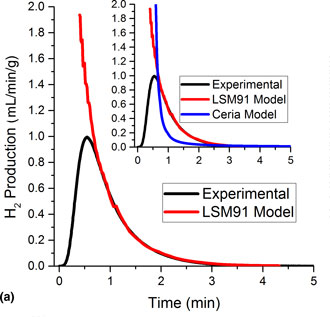Crossref Citations
This article has been cited by the following publications. This list is generated based on data provided by
Crossref.
Carrillo, Alfonso J.
Rupp, Jennifer L. M.
and
Coronado, Juan M.
2019.
Energy Storage and Conversion Materials.
p.
136.
Bork, Alexander H.
Povoden-Karadeniz, Erwin
Carrillo, Alfonso J.
and
Rupp, Jennifer L.M.
2019.
Thermodynamic assessment of the solar-to-fuel performance of La0.6Sr0.4Mn1-yCryO3- perovskite solid solution series.
Acta Materialia,
Vol. 178,
Issue. ,
p.
163.
Carrillo, Alfonso J.
Bork, Alexander H.
Moser, Thierry
Sediva, Eva
Hood, Zachary D.
and
Rupp, Jennifer L. M.
2019.
Modifying La0.6Sr0.4MnO3 Perovskites with Cr Incorporation for Fast Isothermal CO2‐Splitting Kinetics in Solar‐Driven Thermochemical Cycles.
Advanced Energy Materials,
Vol. 9,
Issue. 28,
Qian, Xin
He, Jiangang
Mastronardo, Emanuela
Baldassarri, Bianca
Wolverton, Christopher
and
Haile, Sossina M.
2020.
Favorable Redox Thermodynamics of SrTi0.5Mn0.5O3−δ in Solar Thermochemical Water Splitting.
Chemistry of Materials,
Vol. 32,
Issue. 21,
p.
9335.
Kudyakova, V.S.
Politov, B.V.
Suntsov, A. Yu
and
Kozhevnikov, V.L.
2020.
Phase stability and thermodynamic properties of PrBaMn2O6–.
Journal of Solid State Chemistry,
Vol. 287,
Issue. ,
p.
121382.
Bork, Alexander H.
Carrillo, Alfonso J.
Hood, Zachary D.
Yildiz, Bilge
and
Rupp, Jennifer L. M.
2020.
Oxygen Exchange in Dual-Phase La0.65Sr0.35MnO3–CeO2 Composites for Solar Thermochemical Fuel Production.
ACS Applied Materials & Interfaces,
Vol. 12,
Issue. 29,
p.
32622.
Carrillo, Alfonso J.
Kim, Kun Joong
Hood, Zachary D.
Bork, Alexander H.
and
Rupp, Jennifer L. M.
2020.
La0.6Sr0.4Cr0.8Co0.2O3Perovskite Decorated with Exsolved Co Nanoparticles for Stable CO2Splitting and Syngas Production.
ACS Applied Energy Materials,
Vol. 3,
Issue. 5,
p.
4569.
Kudyakova, V.S.
Shalamova, A.M.
Politov, B.V.
and
Suntsov, A. Yu
2021.
Specific interrelations of magnetic, thermodynamic and structural properties in highly non-stoichiometric PrBaMnFeO6− double perovskite.
Journal of Alloys and Compounds,
Vol. 886,
Issue. ,
p.
161133.
Irvine, John
Rupp, Jennifer L. M.
Liu, Gang
Xu, Xiaoxiang
Haile, Sossina
Qian, Xin
Snyder, Alem
Freer, Robert
Ekren, Dursun
Skinner, Stephen
Celikbilek, Ozden
Chen, Shigang
Tao, Shanwen
Shin, Tae Ho
O’Hayre, Ryan
Huang, Jake
Duan, Chuancheng
Papac, Meagan
Li, Shuangbin
Celorrio, Veronica
Russell, Andrea
Hayden, Brian
Nolan, Hugo
Huang, Xiubing
Wang, Ge
Metcalfe, Ian
Neagu, Dragos
and
Martín, Susana Garcia
2021.
Roadmap on inorganic perovskites for energy applications.
Journal of Physics: Energy,
Vol. 3,
Issue. 3,
p.
031502.
Naik, J. Madhusudhan
Ritter, Clemens
Bulfin, Brendan
Steinfeld, Aldo
Erni, Rolf
and
Patzke, Greta R.
2021.
Reversible Phase Transformations in Novel Ce‐Substituted Perovskite Oxide Composites for Solar Thermochemical Redox Splitting of CO2.
Advanced Energy Materials,
Vol. 11,
Issue. 16,
Qian, Xin
He, Jiangang
Mastronardo, Emanuela
Baldassarri, Bianca
Yuan, Weizi
Wolverton, Christopher
and
Haile, Sossina M.
2021.
Outstanding Properties and Performance of CaTi0.5Mn0.5O3–δ for Solar-Driven Thermochemical Hydrogen Production.
Matter,
Vol. 4,
Issue. 2,
p.
688.
Pérez, Alejandro
Orfila, María
Linares, María
Sanz, Raúl
Marugán, Javier
Molina, Raúl
and
Botas, Juan A.
2022.
Hydrogen production by thermochemical water splitting with La0.8Al0.2MeO3-δ (Me= Fe, Co, Ni and Cu) perovskites prepared under controlled pH.
Catalysis Today,
Vol. 390-391,
Issue. ,
p.
22.
Qian, Xin
Haile, Sossina M.
Davenport, Timothy C.
and
Mastronardo, Emanuela
2022.
Experimental protocols for the assessment of redox thermodynamics of nonstoichiometric oxides: A case study of YMnO3‐δ.
Journal of the American Ceramic Society,
Vol. 105,
Issue. 6,
p.
4375.
Lou, Jiahui
Tian, Zhenyu
Wu, Yunyun
Li, Xiao
Qian, Xin
Haile, Sossina M.
and
Hao, Yong
2022.
Thermodynamic assessment of nonstoichiometric oxides for solar thermochemical fuel production.
Solar Energy,
Vol. 241,
Issue. ,
p.
504.
Zhang, Dawei
Park, Jiyun
Xu, Boyuan
Liu, Cijie
Li, Wei
Liu, Xingbo
Qi, Yue
and
Luo, Jian
2023.
Unusual aliovalent doping effects on oxygen non-stoichiometry in medium-entropy compositionally complex perovskite oxides.
Dalton Transactions,
Vol. 52,
Issue. 4,
p.
1082.
Mastronardo, Emanuela
Qian, Xin
Coronado, Juan M.
and
Haile, Sossina M.
2023.
A and B site Co-doping of CaMnO3: a route to enhanced heat storage properties.
Journal of Materials Chemistry A,
Vol. 11,
Issue. 16,
p.
8858.
Wexler, Robert B.
Stechel, Ellen B.
and
Carter, Emily A.
2023.
Solar Fuels.
p.
1.
Mastronardo, Emanuela
Sánchez, Mario
González-Aguilar, José
and
Coronado, Juan M.
2023.
Experimental assessment of Fe-doped CaMnO3 porous pellets in a bench-scale packed-bed reactor for thermochemical energy storage.
Journal of Energy Storage,
Vol. 57,
Issue. ,
p.
106226.
Zhu, Liya
Yang, Weixu
Pan, Heng
Shao, Zongping
Lu, Youjun
and
Dang, Zhi-Min
2023.
Coupling the full solar spectrum with a two-step thermo-electrolytic cycle for efficient solar hydrogen production.
Energy Conversion and Management,
Vol. 290,
Issue. ,
p.
117161.
Naik, J. Madhusudhan
Bulfin, Brendan
Triana, Carlos A.
Stoian, Dragos Constantin
and
Patzke, Greta R.
2023.
Cation-Deficient Ce-Substituted Perovskite Oxides with Dual-Redox Active Sites for Thermochemical Applications.
ACS Applied Materials & Interfaces,
Vol. 15,
Issue. 1,
p.
806.






